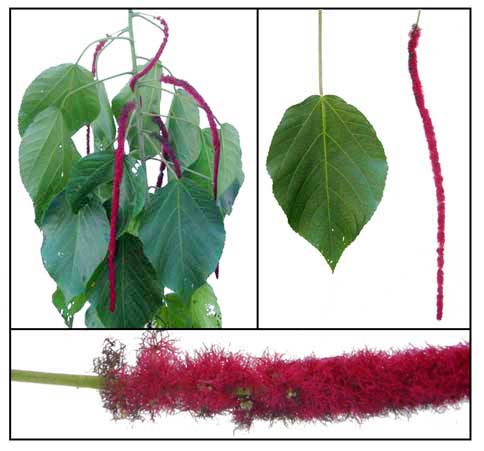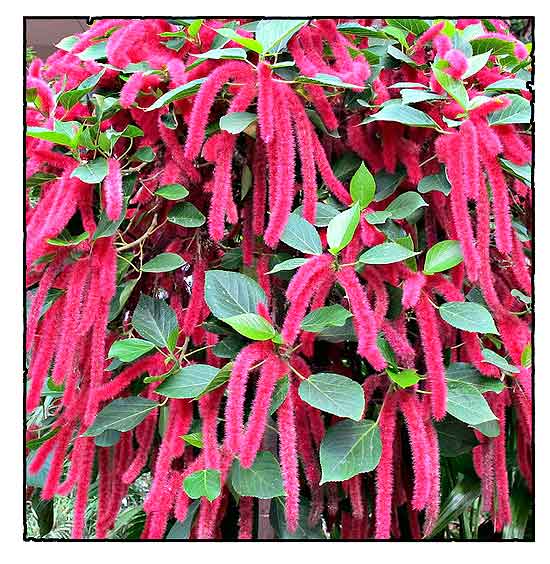|
 Gen info Gen info
- Acalypha is a genus of flowering plants in the family Euphorbiaceae. It is the sole genus of the subtribe Acalyphinae. It is one of the largest euphorb genera, with about 450-462 species. (22)
- Etymology: The genus name Acalypha derives from Ancient Greek akaluphe (nettle) or akalephe, meaning "unpleasant to touch", referring to the nettle-like leaves. (22) The species name hispida derives from Latin, meaning "bristly", referring to the pendant flowers that resemble brushes. (23)
- It has gained the Royal Horticultural Society's Award of Garden Merit. (23)
Botany
• Acalypha hispida is a shrub growing to a height of 1-3meters. Leaves
are alternate, petioled 2-11 cm long, broad-ovate, bright green atop,
pale green underneath, with crenulate-serrate margins. Inflorescence
is axillary, solitary, in long pendant spikes, up to 15-40 cm long.
Flowers are small and bright red.
• Shrubs, 1-3 m tall. Branchlets grayish tomentulose when young. Stipules triangular, 6-10 mm, pilose; petiole 4-8 cm; leaf blade broadly ovate or ovate, 8-20 × 5-14 cm, papyraceous, base broadly cuneate, obtuse, or subcordate, margin coarsely serrate, apex acuminate or acute; basal veins 3-5. Plants dioecious. Only female flowers known. Female flowers 3-7 in each bract, fascicled, subsessile; spikes 15-30 cm, axillary, pendulous; peduncle short, pubescent; bracts scattered, ovate-rhombic, ca. 1 mm, entire; sepals (3 or)4, subovate, ca. 1 mm, acute, puberulent; ovary subglobose, densely hirtellous; styles 3, 5-7 mm, laciniate, crimson or red-purple.
Distribution
- Cultivated, not naturalized.
-
Popular garden cultivation for its
decorative red catkins.
- Nowhere spontaneous.
 Constituents Constituents
- Phytochemical screening yielded flavonoids, carbohydrates, phenols and alkaloids.
- Plant has yielded gallic acid, corilagin, cycloartane-type triterpenoids, quercetin and kaempferol derivatives.
- Leaves yielded kaempferol 3-O-rutinoside.
(16)
- Phytochemical screening of hexane extract (non-polar fraction) of leaves and twigs yielded flavonoids, carbohydrates, phenols, anthraquinones, cardiac glycosides, proteins, and alkaloids, with an absence of tannins, sterols and saponins.
(see study below) (9)
- Proximate composition of leaves showed moisture (11.02%), crude fate (6.15%), ash (10.32%), crude protein (13.78%), crude fiber (10.25%) and carbohydrate (44.48%). Aqueous and methanolic extracts of leaves yielded phenolics, flavonoids, hydroxyanthraquinones, saponins, steroids, and phlobatannins.
(10)
- Ethanol and aqueous extracts
of leaves yielded flavonoid content of 126.30 and 149.72 mg QE/g dry extract, and phenolic content of 130.51 and 173.80 mg GAE/g dry extract, respectively. (see study below) (18)
- Screening of dried powder leaves yielded carbohydrates, flavanoids, cardiac glycosides, anthraquinone glycosides, saponins, steroids, and tannins.
(19)
- Phytochemical screening of leaf extracts yielded tannin, alkaloid, saponin and flavonoids, with absence of hydrogen cyanide and carbohydrates. (21)

Properties
- Diuretic, emollient, expectorant and laxative.
- Studies suggest antidiarrheal, anti-leishmanial, antioxidant, trypanocidal.
antiulcer, antitumor, anti-inflammatory, wound healing, antibacterial properties.
Parts
utilized
Bark, flower, leaves, root
Propagated by stem cuttings.
Uses
Folkloric
• Not known in the Philippines for
medicinal applications.
• In Indonesia,
a root and flower decoction is used for hemoptysis. Leaf poultice used
for leprosy. Leaves used to treat thrush.
• In Malaya, decoction
of leaves and flowers taken internally as laxative and diuretic for
gonorrhea; externally, applied as emollient to wounds and ulcers. Bark used as expectorant and for asthma.
• In Africa, bark
root used for pulmonary problems; leaf for leprosy, and flower for kidney
ailments and as diuretic.
• In West Nigeria, leaves and stems soaked and boiled in water, used for skin rashes. (13)
• In India, reported Mawasi tribal use of flowers for diarrhea. (14)
Studies
• Antimicrobial:
Studies of leaf extracts isolated gallic acid, corilagin and geranin
responsible for antimicrobial activity. (2)
• Trypanocidal:
Aqueous extract of Acalypha hispida leaves suggest trypanocidal effect. (3)
• Anti-ulcer / Anti-tumor:
Studies yielded geraniin and dehydroellagitannins which suggest diverse
biological properties including anti-ulcer and anti-tumor effects, antibacterial
activity against helicobacter pylori and antifungal activity.
• Phytochemicals: Phytochemical studies yield phenolics, flavonoids, hydroxyanthraquinones
and saponins. It also detected steroids , phlobatannins and glycosides.
• Anthocyanins:
Study isolated three anthocyanins from the red flowers of the chenille plant. (6)
• Anti-Leishmanial:
In a study of three Acalypha species, only A. hispida showed to have anti-leishmanial activity with an IC50 of 71.75 µg/mL (8)
• Antioxidant / Antioxidant:
Study evaluated a hexane extract for phytoconstituents and antioxidant activity. Study yielded flavonoids, carbohydrates, phenols and alkaloids. Results showed significant antioxidant activities when compared to ascorbic acid. The scavenging activity could be linked to flavonoid and phenol contents. (see constituents above) (9)
• Toxicity Studies:
Study in mice toxicity of combined extracts of three Acalypha species viz. Acalypha hispida, A. nervosa and A. fruiticosa. Subacute toxicity study showed no mortalities or evidence of adverse effects at highest dose of 2000 mg /kg of crude extracts. (11) Study evaluated the acute toxicity safety of ethanolic extract of A. hispida leaves in female Sprague-Dawley rats. Single extract doses of 2, 4, 8, and 16 g/kbw was administered orally. Results showed the ethanolic extract was relatively harmless with LD50 of 16 g/kbw, with no effect on body weight and no clinical signs of toxicity during the observation periods. (26)
• Antidiarrheal / Combined Effects:
Study evaluated the antidiarrheal potential of combined 70% hydroethanolic extracts of Acalypha hispida, A. nervosa and A. fruiticosa in castor oil-induced diarrhea in wistar rats. Results showed dose-dependent delay in the onset of induced diarrhea and also significant reduction in the number of diarrheal episodes and number of animals exhibiting diarrhea. Loperamide was used as standard drug. (12)
• Essential Oil / Larvicidal: Study of leaves for essential oil yielded main constituents of neral (11.04%), citral (12.87%), 6,10,14, trimethyl-2-pentadecanone (13.43%) and n- hexadecanoic acid (14.69%). On toxicity for brine shrimps larvae (Artemia salina), LC50 value was 122.28 µg/mL, while activity against Anopheles gambiae showed an LC50 of 125 µg/mL. (15)
• Anti-Inflammatory / Antioxidant / Leaves: Study evaluated the anti-inflammatory, antioxidant activity, and bioactive plant polyphenols of ethanol and aqueous extracts of leaves. Both extracts showed statistically significant inhibition of carrageenan and histamine induced paw volume. Both extracts showed DPPH scavenging, Fe+2 iron chelating, NO scavenging, and concentration dependent reducing power ability. The anti-inflammatory activity may be due to the high presence of ellagic acid, contributed, too, by other phenolic contents. (see constituents above) (18)
• Antimicrobial / Cytotoxic / Leaves: Study evaluated an ethanolic extract of leaves for cytotoxic and antimicrobial activities. Cytotoxic activity by brine shrimp lethality showed potent cytotoxic effect with LC50 19.95 µg/ml, comparable to standard cytotoxic drub chloramphenicol (LC50 7 µg/ml). The extract showed antibacterial activity against Salmonella typhi and moderate activity against Enterococcus coli, Streptococcus saprophyticus and Streptococcus agalactin. (20)
• Antibacterial / Leaves: Study evaluated the antibacterial properties of ethanol, methanol, chloroform and water extracts of leaves against E. coli, S. aureus, P. aeruginosa, and S. typhi. The test organisms were susceptible to the extracts in varying degrees, with the methanol extract showed more antibacterial activity. (21)
• Increased Antioxidant Defense / Nanoextract of Leaves: Study evaluated the effect of nanoextract of A. hispida leaves on antioxidant defense and microstructure of the liver and kidney in diabetic rats. The extract (300 mg/kg) and nanoextract (30 and 60 mg/kbw) of A. hispida improved blood chemistry (ALT, AST, creatinine, urea), decreased malondialdehyde (MDA) level and increased total SPOD and catalase (CAT) activity in the liver and kidney. The nanoextract at 60 mg/kbw showed best effect in suppressing microstructure damage to the liver and kidney. Results suggest the nanoextract of A. hispida increased antioxidant defense and suppressed microstructure damage in the liver and kidney of diabetic rats. (23)
• Effect on Wound Healing of Traumatic Ulcer / Leaves: Study evaluated the effect of cats tail leaves extract on wound healing of traumatic ulcers in the oral cavity mucosa of male Wistar rat. Leaves extract concentration of 50, 75, and 100% showed significant wound diameter decrease in every treatment group. Most significant wound diameter decrease group was 100%. The leaves treatment group showed greater wound healing effect than povidone iodine control group. (24)
• Hypoglycemic / Antioxidant / Leaves: Study evaluated the polyphenol profile, antioxidant,
α-glucosidase and α-amylase inhibitory and hypoglycemic activities of A. hispida leaf extract in vivo. Powdered Acalypha hispida leaves were macerated with 70 and 96% ethanol and decocted in distilled water. The ethanol and aqueous extracts showed strong antioxidant activity (IC50<10 µg/ml). The 96% ethanol extract showed very high inhibition of α-glucosidase and α-amylase activities. The 96% ethanol extract at 300 mg/kg dose showed significant hypoglycemic activity in experimental rats. Results suggest potential for the ethanol leaf extract as effective antihyperglycemic agent via inhibition of α-glucosidase and α-amylase. (25)
Toxicity concerns
- While some blogs assert the plant is not toxic, as many say it is toxic, especially dermatologically.
-
Little may happen from merely touching the leaves and flowers. However, the sap from the leaves and stems are poisonous and the moisture inside the plant can cause considerable skin and mucous membrane irritation.
- Symptoms: Ingestion causes nausea, vomiting and diarrhea (not a salad ingredient!); skin contact
may cause acute dermatitis which may be severe.
- Care should be observed with small children around and when pruning or cutting the plant
- The toxic principle: diterpene esters.
Availability
- Ornamental cultivation.
- Seeds in the cybermarket. |


 Gen info
Gen info



